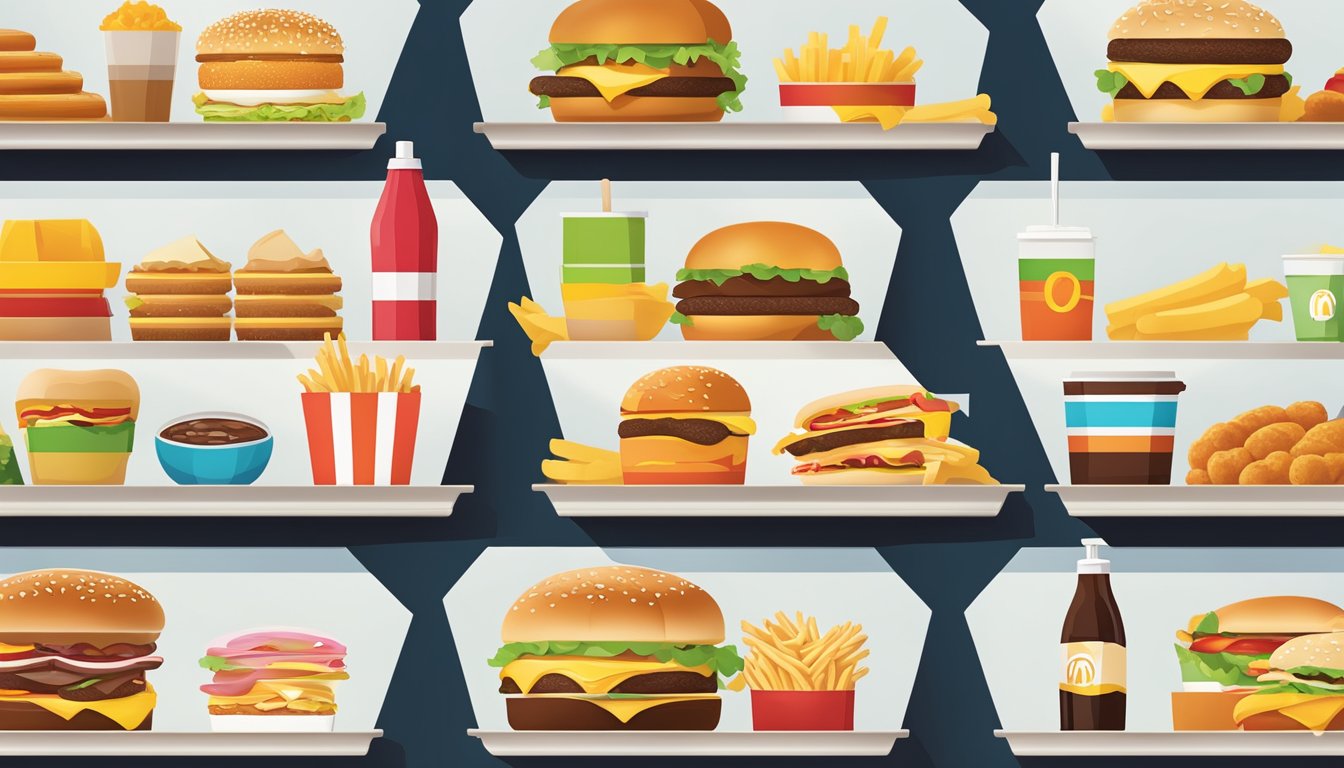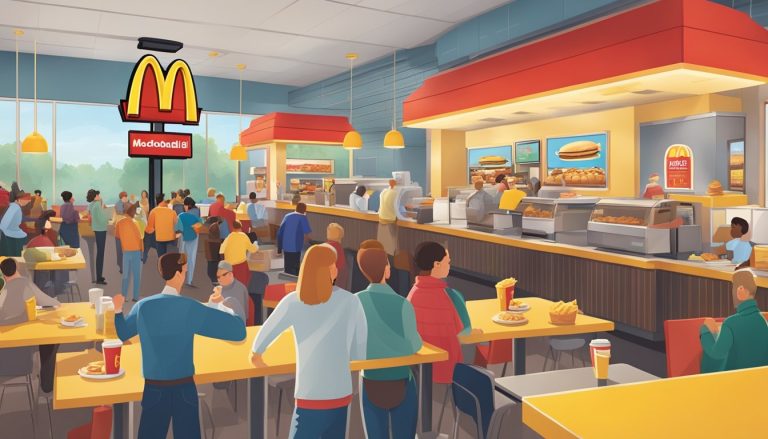McDonald’s introduction of the Egg McMuffin in 1971 revolutionized fast food breakfast offerings. This iconic menu item paved the way for an expanded morning menu that would eventually become available all day long. The launch of McDonald’s All-Day Breakfast in October 2015 marked a significant shift in the fast-food industry, challenging traditional mealtime norms.
McDonald’s breakfast innovations have prompted competitors to develop and expand their own morning menus, leading to what industry insiders call the “Breakfast Wars.” Fast food chains like Burger King, Taco Bell, and others have responded by introducing new breakfast items and extending their breakfast hours to compete with the Golden Arches.
This competitive landscape has resulted in a broader range of breakfast options for consumers across various fast food establishments. From value menus to unique offerings, rival chains have sought to differentiate themselves while still addressing the growing demand for convenient morning meals that McDonald’s helped cultivate.
Understanding McDonald’s Impact on the Fast-Food Industry
McDonald’s has revolutionized the fast-food landscape through innovation, efficiency, and global expansion. Its influence extends far beyond its own restaurants, shaping industry practices and consumer expectations worldwide.
Historical Perspective and Brand Evolution
McDonald’s journey began in 1940 when Richard and Maurice McDonald opened their first restaurant in California. The brothers developed the “Speedee Service System,” prioritizing speed and efficiency in food preparation. This innovation laid the groundwork for modern fast-food operations.
In 1955, Ray Kroc joined as a franchise agent, opening the first franchised location in Illinois. Kroc’s vision propelled McDonald’s rapid expansion and standardization across the United States and eventually globally.
The iconic Golden Arches logo, introduced in 1968, became a symbol of consistency and quality in fast food. This branding helped McDonald’s establish a strong, recognizable identity worldwide.
McDonald’s as a Market Leader
McDonald’s dominance in the fast-food industry stems from its commitment to innovation and adaptation. The company continually refines its menu, introducing items like the Big Mac and Egg McMuffin that have become industry staples.
Its breakfast offerings, launched in the 1970s, transformed morning dining habits. All-day breakfast, introduced in 2015, further solidified McDonald’s position in this lucrative market segment.
The company’s global presence, spanning over 100 countries, allows it to adapt to local tastes while maintaining core menu items. This balance of standardization and localization has been widely emulated by competitors.
Fast-Food Industry Dynamics
McDonald’s success has shaped industry-wide practices. Its focus on speed, affordability, and consistency set new standards for fast-food operations. Competitors often benchmark their performance against McDonald’s metrics.
The company’s supply chain management and franchise model have become industry benchmarks. Many fast-food chains have adopted similar strategies to streamline operations and ensure product consistency.
McDonald’s marketing campaigns, such as the “I’m Lovin’ It” slogan, have influenced how fast-food brands communicate with consumers. Its promotional strategies, including Happy Meals and movie tie-ins, are now common industry practices.
Exploring the Breakfast Segment
The breakfast segment has become a critical battleground for fast food chains. McDonald’s pioneering efforts have shaped industry trends and consumer expectations, driving innovation and competition across the sector.
Breakfast as a Revenue Driver
Breakfast has emerged as a key revenue driver for fast food restaurants. McDonald’s success in this arena has prompted competitors to expand their morning offerings. The U.S. breakfast food market reached $48 billion in 2023, highlighting its significant potential.
Fast food chains have recognized the importance of capturing the early morning crowd. Many have extended their hours to accommodate breakfast seekers. This shift has led to increased foot traffic and sales during traditionally slower periods.
Development of McDonald’s Breakfast Menu
McDonald’s breakfast menu evolution has been instrumental in shaping the fast food breakfast landscape. The introduction of the Egg McMuffin in 1971 marked a turning point in breakfast offerings.
Over the years, McDonald’s has continuously innovated its breakfast menu. Items like Hotcakes and breakfast burritos have become staples. The launch of All-Day Breakfast in 2015 further disrupted the industry, blurring traditional mealtime boundaries.
McDonald’s breakfast innovations have often set industry standards. Competitors frequently introduce similar items to keep pace with changing consumer preferences.
Breakfast Market Analysis
The breakfast market has shown resilience even during economic downturns. Fast food chains have capitalized on this trend by offering affordable breakfast options. McDonald’s has particularly benefited from its established breakfast reputation.
Consumer behavior studies indicate a growing preference for convenient, on-the-go breakfast options. This trend has led to the development of portable menu items across various chains. Health-conscious consumers have also influenced menu offerings, with chains introducing healthier breakfast alternatives.
Market analysis reveals that breakfast culture varies across regions. Fast food chains have adapted their menus accordingly, offering localized breakfast items to cater to different tastes and preferences.
Competitive Landscape and Customer Experience

McDonald’s breakfast offerings have significantly impacted the fast food industry, prompting competitors to adapt and innovate. This has led to a dynamic landscape where chains vie for customer loyalty through menu enhancements and improved dining experiences.
Competitors’ Response to McDonald’s Breakfast
Burger King introduced the Croissan’wich in 1983 as a direct response to McDonald’s Egg McMuffin. Wendy’s launched its breakfast menu nationwide in 2020, featuring unique items like the Breakfast Baconator. Starbucks expanded its food options to include hot breakfast sandwiches and wraps.
Subway began offering breakfast in 2010, focusing on customizable egg-based sandwiches. Shake Shack entered the breakfast market in select locations with egg sandwiches and morning-themed shakes.
These competitors have tailored their breakfast menus to differentiate themselves from McDonald’s while still catering to similar customer demands for convenience and taste.
Assessing the Breakfast Menus of Competitors
Burger King’s breakfast menu closely mirrors McDonald’s, offering similar items like breakfast sandwiches and platters. Wendy’s differentiates itself with fresher ingredients and made-to-order meals.
Starbucks focuses on premium coffee pairings with its breakfast items. Subway emphasizes customization, allowing customers to build their own breakfast sandwiches.
Shake Shack’s limited breakfast menu features high-quality ingredients and unique flavor combinations.
| Competitor | Key Breakfast Offerings |
|---|---|
| Burger King | Croissan’wich, pancakes |
| Wendy’s | Breakfast Baconator, biscuit sandwiches |
| Starbucks | Egg bites, breakfast sandwiches |
| Subway | Build-your-own breakfast sandwiches |
| Shake Shack | Egg sandwiches, breakfast-themed shakes |
Customer Experience Enhancement
Fast food chains have invested in improving customer experience to compete with McDonald’s breakfast dominance. Drive-thru services have been optimized for faster breakfast service, with many chains implementing dual-lane systems.
Mobile ordering and loyalty programs have become standard, allowing customers to pre-order breakfast items for quick pickup. Chains have also focused on interior redesigns to create more welcoming morning environments.
Franchisees play a crucial role in maintaining consistent quality and service across locations. Training programs emphasize speed and accuracy during peak breakfast hours.
Brand loyalty is cultivated through targeted marketing campaigns and limited-time breakfast promotions. Chains regularly introduce new breakfast items to meet evolving customer preferences and maintain interest in their morning offerings.
Innovation and Marketing Strategies

McDonald’s has implemented innovative approaches to menu development, technology integration, and marketing campaigns to stay competitive in the fast food industry. These strategies have influenced both consumer preferences and competitor offerings.
Menu Innovation and Healthier Options
McDonald’s has expanded its menu to include healthier alternatives and cater to changing consumer preferences. The introduction of salads, wraps, and fruit options has appealed to health-conscious customers. The company has also embraced plant-based trends with the launch of the McPlant burger in select markets.
Calorie counts and nutritional information are now prominently displayed, allowing customers to make informed choices. McDonald’s has reduced artificial ingredients in many items and improved the quality of its core products, such as using cage-free eggs and antibiotic-free chicken.
Technological Advances in Service
McDonald’s has invested heavily in digital technology to enhance customer experience and streamline operations. Self-service kiosks in restaurants allow for customized orders and reduced wait times. The McDonald’s mobile app enables convenient ordering, payment, and personalized deals.
The company has implemented AI-driven menu boards that adjust displayed items based on time of day, weather, and current restaurant traffic. Drive-thru service has been enhanced with automated voice ordering systems at some locations.
McDonald’s has also partnered with food delivery services to expand its reach and cater to the growing demand for convenient home delivery options.
Effective Marketing Campaigns
McDonald’s marketing strategies have evolved to embrace digital platforms while maintaining traditional media presence. The company leverages social media to engage with younger demographics and create viral content. Influencer partnerships and user-generated content campaigns have boosted brand visibility and authenticity.
The “I’m Lovin’ It” slogan remains a cornerstone of McDonald’s marketing, reinforcing brand recognition globally. Localized campaigns tailored to specific markets have helped McDonald’s resonate with diverse cultures and tastes.
McDonald’s has also utilized data-driven marketing to deliver personalized offers through its mobile app and loyalty program. This approach has increased customer retention and frequency of visits.
Operational Excellence and Supply Chain

McDonald’s breakfast menu success stems from its robust operational systems and efficient supply chain. The company’s strategic approach optimizes costs while ensuring consistent quality across locations.
Supply Chain Management
McDonald’s employs a sophisticated supply chain network to support its breakfast offerings. The company partners with select suppliers to source ingredients like eggs, bacon, and coffee beans. These partnerships enable McDonald’s to maintain quality standards and negotiate favorable pricing.
McDonald’s uses regional distribution centers to streamline inventory management. This system allows for quick replenishment of breakfast items, reducing waste and ensuring freshness. The company also implements just-in-time delivery practices to minimize storage costs and maintain product quality.
To enhance efficiency, McDonald’s leverages technology in its supply chain. Radio-frequency identification (RFID) tags track shipments, while predictive analytics help forecast demand for breakfast items. These tools enable McDonald’s to respond swiftly to changes in consumer preferences and market conditions.
Operational Efficiency and Economies of Scale
McDonald’s achieves operational efficiency through standardized processes and equipment. Breakfast preparation follows strict guidelines, ensuring consistency across locations. Specialized cooking equipment, such as custom griddles and toasters, accelerates food production while maintaining quality.
The company’s massive scale allows for significant cost savings. Bulk purchasing of breakfast ingredients reduces per-unit costs. McDonald’s also benefits from shared marketing and administrative expenses across its vast network of restaurants.
To further boost efficiency, McDonald’s continually refines its breakfast menu. The company regularly evaluates item performance, removing underperforming options and introducing new products. This approach optimizes kitchen operations and reduces complexity.
Employee training programs focus on maximizing productivity during breakfast hours. Cross-training enables staff to handle multiple roles, improving flexibility during peak periods. This strategy enhances service speed and customer satisfaction.
Digital Transformation and Consumer Trends

McDonald’s has embraced digital solutions and adapted to shifting consumer preferences. The company leverages technology and social media to enhance customer experiences and stay competitive in the fast food industry.
Adoption of Digital Solutions
McDonald’s acquired Dynamic Yield in 2019, integrating AI-powered digital menu boards. These menus adjust based on factors like weather, time of day, and local events. The company’s mobile app allows for convenient ordering and payment. McDonald’s has also partnered with delivery services to expand its reach.
Digital kiosks in restaurants provide a self-service option, reducing wait times and improving order accuracy. The McDonald’s app offers personalized deals and a loyalty program, incentivizing repeat visits.
Shifts in Consumer Preferences
Consumer demand for healthier options has influenced McDonald’s menu. The company introduced more salads, wraps, and fruit options. McCafé expanded to meet the growing coffee culture, offering premium beverages.
Customization became a key focus, with “Create Your Taste” kiosks allowing customers to build personalized burgers. McDonald’s also improved ingredient transparency, addressing concerns about food quality and sourcing.
Social Media and Consumer Engagement
McDonald’s actively engages with customers on social media platforms. The company uses Twitter, Instagram, and Facebook for promotions, customer service, and brand building.
User-generated content campaigns encourage customers to share their McDonald’s experiences. The brand responds to trending topics and participates in viral challenges to stay relevant.
Social media also serves as a feedback channel, allowing McDonald’s to quickly address concerns and gather insights for menu improvements and marketing strategies.
Social Responsibility and Corporate Image

McDonald’s has implemented various initiatives to enhance its corporate image and demonstrate social responsibility. These efforts span sustainability, health and safety, and community engagement.
Sustainability Initiatives
McDonald’s has made significant strides in environmental sustainability. The company has committed to sourcing 100% of its guest packaging from renewable, recycled, or certified sources by 2025. In the United States, McDonald’s has already achieved its goal of using cage-free eggs in breakfast items, two years ahead of schedule.
The fast-food giant has also set targets to reduce greenhouse gas emissions in its restaurants and offices by 36% by 2030. This includes implementing energy-efficient equipment and exploring renewable energy sources.
McDonald’s is working to improve its supply chain sustainability. The company has pledged to eliminate deforestation from its global supply chain by 2030, focusing on key commodities like beef, soy, palm oil, and coffee.
Commitment to Health and Safety
McDonald’s has responded to health concerns by evolving its menu offerings. The company has introduced more salads, fruit options, and lower-calorie items to cater to health-conscious consumers.
In 2018, McDonald’s removed artificial preservatives from several of its classic burgers. The company has also committed to reducing sodium across its menu items.
Food safety remains a top priority. McDonald’s implements rigorous food safety protocols in its restaurants and throughout its supply chain. The company regularly audits its suppliers and conducts food safety training for employees.
Corporate Social Responsibility Efforts
McDonald’s engages in various corporate social responsibility initiatives. The Ronald McDonald House Charities, supported by the company, provides housing and support for families with sick children receiving medical treatment.
The company has implemented educational programs in many countries. In the United States, McDonald’s offers tuition assistance to eligible employees through its Archways to Opportunity program.
McDonald’s also supports local communities through disaster relief efforts and volunteer programs. The company encourages its franchisees to engage in local charitable activities and community events.
Expansion and Market Strategies
McDonald’s global expansion and adaptation to local tastes have been key pillars of its breakfast menu success. These strategies have allowed the company to dominate markets worldwide while maintaining brand consistency.
Global Expansion and Market Penetration
McDonald’s rapid international growth has been fueled by franchising. This model allows for quick market entry with reduced capital investment. The company carefully selects franchise partners who understand local markets and can implement McDonald’s systems effectively.
In emerging markets, McDonald’s often introduces its breakfast menu as a way to establish a foothold. This strategy has proven successful in countries like China, where Western-style breakfasts were relatively uncommon.
McDonald’s uses its strong brand recognition to attract customers to its breakfast offerings in new markets. The company’s marketing emphasizes familiar elements while highlighting unique local menu items.
Adapting to Regional Tastes and Preferences
McDonald’s modifies its breakfast menu to suit local palates. In India, the menu features vegetarian options like the Veg McMuffin. Japan offers teriyaki chicken breakfast sandwiches.
The company conducts extensive market research to identify popular local breakfast foods. This information guides menu development and helps ensure new items resonate with target consumers.
McDonald’s also adapts its marketing messages to align with cultural norms and values. In some markets, breakfast is positioned as a family meal, while in others it’s marketed to busy professionals.
By balancing global consistency with local relevance, McDonald’s has successfully expanded its breakfast menu worldwide.
Conclusion and Future Outlook

McDonald’s breakfast menu has significantly impacted the fast-food landscape. Competitors have been compelled to expand their morning offerings and extend breakfast hours to keep pace.
The breakfast segment continues to be a key revenue driver for McDonald’s and its rivals. Market expansion in this area remains a priority for many chains, with new menu items and promotions targeting early-day diners.
Technological innovation plays a crucial role in the future of fast-food breakfast. Mobile ordering, delivery services, and personalized marketing are becoming increasingly important for capturing breakfast customers.
Challenges persist in maintaining food quality and operational efficiency while serving breakfast items throughout the day. Chains must balance customer demand with kitchen logistics and staff training.
Leadership in the fast-food industry will likely be determined by those who can best adapt to changing consumer preferences in the breakfast market. This includes offering healthier options and catering to diverse dietary needs.
Disruption in the form of new entrants and changing eating habits may force established players to rethink their breakfast strategies. Flexibility and responsiveness to market trends will be essential for continued success.
Marketing strategies focused on convenience, value, and quality will remain critical in attracting and retaining breakfast customers. Brands that effectively communicate these attributes stand to gain market share.




